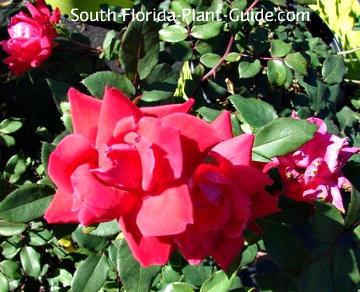

The disease, which is now thought to be a negative sense RNA virus is transferred from plant to plant by a very tiny eriophyiid mite called Phyllocoptes fructiphilus. At our home the two roses I suspected with the disease included an ‘Archduke Charles’ and a ‘Pinkie’ climbing rose (neither of which were positively confirmed). The samples sent to me from Denton included yellow peach and red Knockout roses. are beginning to see the disease in cultivated roses. Wild multiflora roses are the most susceptible, though gardeners throughout the eastern U.S. The symptoms seen on these rose cuttings, I learned, were classic: excessive thorn production, leaf distortion and excessive branch development, known as witches broom, at the ends of branches. Horticulture agent Janet Laminack wanted to know if the sample was rose rosette. I had never heard of rose rosette until a recent sample arrived from the Denton County Extension office. Yellow peach Knockout Rose Rosette Disease Yellow peach Knockout rose showing the excessive thorniness associated with rose rosette disease. Within a relatively short period of time they had begun to show symptoms of rose rosette, a fatal virus disease of roses. This weekend I regretfully cut down two rose bushes on the side of my home. Rose rosette disease transmitted by a mite There is no remedy.įor more images of the problem, see Neil Sperry’s write-up at:įrom Texas AgriLife Extension, Dr. This commercial landscaper on Legacy north of 121 needs to remove all plants that show any signs. Once you see rosette in real life, you'll begin seeing it fairly commonly. Afflicted plants need to be removed entirely – roots, tops and all – and destroyed. It has probably spread to your plants from others in your neighborhood, carried by a tiny mite. That's the fatal rose rosette virus, and it is becoming more and more common in Texas and America. ‘Knock Out’ s seem especially vulnerable.Īpril 23: Garden Tip: It's sad news when your rose bush develops strong bull canes or witches' brooms of new growth that are covered with spines. It’s a horrific problem for serious rose growers. They look like they have been hit by 2,4-D drift. Growth is typically very red, and the buds fail to open properly (but not like damage of thrips). Neil’s Answer: The best way I can describe RRV when I don’t have access to a photo is that the plants produce extremely strong “bull” canes that have probably 10 times the thorns of healthy stems. Does Mike Merchant have any information about it? What do you have written or do you know of good sources for information on this new rose problem? I think I saw it today. Black spot is a common problem and learn about killing aphids on rose bushes to keep the bugs from destroying your flowers.Rose Rosette Disease (RRD) transmitted by a miteĭo you have a Beauty-Turned-Into-A-Beast problem with your ‘Knock-Out’ rose bushes!?!? It is NOT the fault of the rose variety, i.e., it is the fault of a little mite and a virus named Rose Rosette Virus (RRV). Keep an eye on your roses after planting. Place each rose bush at the desired location, fill the trench back in, and water to gain a rose garden and rose hedge all in one. Digging a straight trench works well for bare root shrubs. Once your plans are mapped out, plant your roses. Spacing roses two to three feet apart is generally a safe distance. Base your decisions on the width of your shrubs and how dense you’d like the fence. Planning ensures your landscaping project is successful and fits your lifestyle.Īfter planning, roughly space out the size of your hedge and how far apart the roses as hedges should be. Think about what height you want your hedge roses to be, how much you’re willing to prune the shrubs, and the water and soil requirements. Before trying to grow rose bushes, the first step is to consider what your requirements for the project are. There are a few things you need to do before you have a picturesque privacy hedge. Plants for Any Support System – Prairie Climbing Rose (Rosa setigera).Sweet-Briar Rose (Rosa rubiginosa) – Roses with a Surprise Scent.Regularly Blooming Roses: Chinese Rose (Rosa chinensis).Burnet Rose (Rosa spinosissima) – Hardy Roses as Hedges.Roses with Coastal Vibes: Beach Rose (Rosa rugosa).


 0 kommentar(er)
0 kommentar(er)
